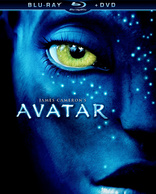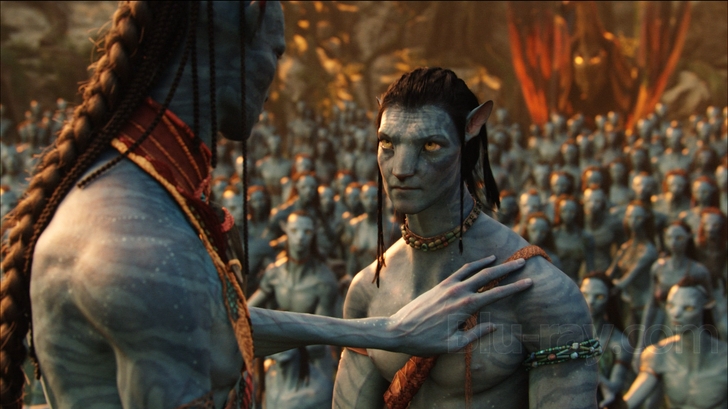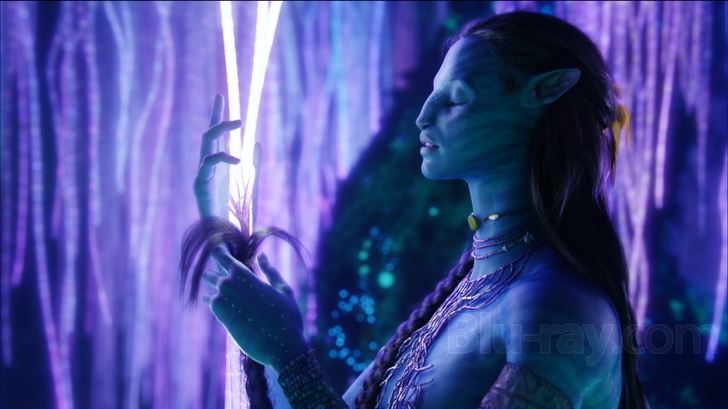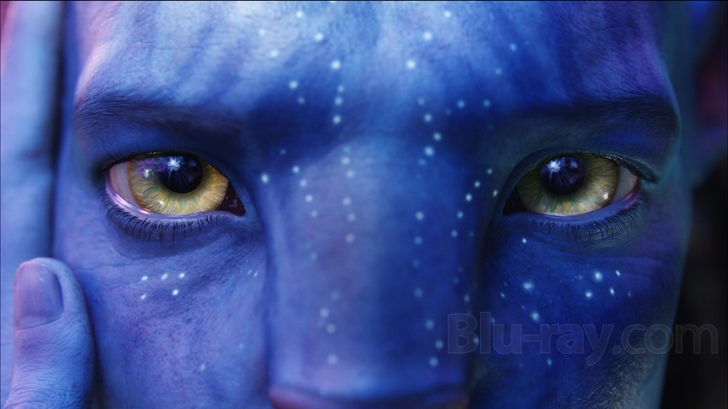Avatar Blu-ray Movie
HomeAvatar Blu-ray Movie 
Blu-ray + DVD20th Century Fox | 2009 | 162 min | Rated PG-13 | Apr 22, 2010

Movie rating
7.8 | / 10 |
Blu-ray rating
| Users | 4.6 | |
| Reviewer | 4.0 | |
| Overall | 4.4 |
Overview
Avatar (2009)
An ex-Marine finds himself thrust into hostilities on an alien planet filled with exotic life forms. As an Avatar, a human mind in an alien body, he finds himself torn between two worlds, in a desperate fight for his own survival and that of the indigenous people.
Starring: Sam Worthington, Zoe Saldaña, Sigourney Weaver, Stephen Lang, Michelle RodriguezDirector: James Cameron
| Adventure | Uncertain |
| Action | Uncertain |
| Sci-Fi | Uncertain |
| Fantasy | Uncertain |
| Epic | Uncertain |
Specifications
Video
Video codec: MPEG-4 AVC
Video resolution: 1080p
Aspect ratio: 1.78:1
Original aspect ratio: 2.39:1
Audio
English: DTS-HD Master Audio 5.1 (48kHz, 24-bit)
English: Dolby Digital 5.1
English: Dolby Digital 2.0
Spanish: Dolby Digital 5.1
French: Dolby Digital 5.1
Portuguese: Dolby Digital 5.1
Subtitles
English SDH, Portuguese, Spanish
Discs
50GB Blu-ray Disc
Two-disc set (1 BD, 1 DVD)
DVD copy
Packaging
Slipcover in original pressing
Playback
Region A, B (locked)
Review
Rating summary
| Movie | 3.5 | |
| Video | 5.0 | |
| Audio | 5.0 | |
| Extras | 0.0 | |
| Overall | 4.0 |
Avatar Blu-ray Movie Review
What’s big, blue, and reportedly cost nearly $300 million?
Reviewed by Casey Broadwater April 22, 2010Most of us, after the barrage of pre-release hype, long-winded Oscar talk, and water cooler-style have you seen it yet conversations, are least somewhat familiar with the story of Avatar’s 15-year journey from script to screen. But for those of you who’ve been living on a distant planet for the past few years, I’ll recap: Tech-head and film director James Cameron writes a treatment for Avatar back in 1994—when no one besides Hindus had any idea what an avatar was—and plans to shoot the ambitious space odyssey after wrapping on Titanic. “No,” he’s told, “the technology isn’t ready. Plus, it would cost, like, a gajillion dollars.” So what does the man do? He takes a decade off from Hollywood to explore and refine the 3D camera equipment, motion capture systems, and CGI software required to bring his vision of the film’s world to life. He pops up in the media occasionally, shilling an IMAX documentary or claiming—in typical, bigger-than-life James Cameron fashion—to have found the lost tomb of Jesus himself, but generally, he lies low, testing, tinkering. Filming finally begins in 2007, and by this time, the internet buzz is deafening. People—industry insiders and internet lurkers alike— start claiming that Avatar will be unlike anything we’ve ever seen, that it’ll jumpstart a new era in digital filmmaking. So, now we jump to the present. Is it? Did it? Yes, and maybe, with the usual “time will tell” caveat.

Jake Sully, now a Na'vi warrior...
Avatar is, without question, an evolutionary leap forward in motion-capture technology, 3D theatrical presentation—once the headache-inducing province of 1950s B horror—and the seamless melding of live action cinematography and CGI. Unfortunately, it’s also a sloppily scripted mash-up of various anti-colonialist allegories, populated with characters that talk like stereotypes of stereotypes, and self-seriously convinced of the profundity of its well-meaning but poorly executed Save The Earth message. (This, coming from a film being released by the millions in non-biodegradable plastic cases that, like it or not, will one day end up in a landfill somewhere. A topic for another time.) Anyway, Kevin Costner, as John Smith, travels to the New World—a mystical valley called Fern Gully—where he meets Pocahontas, dances with wolves, gets in touch with Gaia and…oh, right, I’m getting those stories jumbled up. Well, so does Avatar. In James Cameron’s version of the well-worn tale, the money-hungry RDA corporation—assisted Blackwater-style by a privatized military force—descends upon the peaceful and verdant planet of Pandora to mine for an almost unobtainably rare mineral called, yes, unobtainium. The only problem is, the Native Americans…sorry, the native Pandorans—a spiritually attuned race called the Na’vi—live in a giant tree atop the planet’s largest unobtainium deposit. Do you see where this is going?
The RDA’s administrator, Parker Selfridge (Giovanni Ribisi), perhaps the biggest corporate prick in the universe, has reluctantly brought along a group of nature-loving scientists, mostly to assist in the campaign to “win the hearts and minds” of the natives. (The language of the Iraq War features prominently in Cameron’s fable. You’ll hear “shock and awe” too.) The scientists, led by Dr. Grace Augustine (Sigourney Weaver), are running the so-called Avatar program, which allows unconscious “drivers” to remotely control half human/half Na’vi hybrids. Corporal Jake Sully (Sam Worthington) is one such driver, but the ability to run and jump around Pandora in a new body means more to him than most. See, Sully is paralyzed below the waist. Plus, Colonel Quaritch—a hardass, built from pure gristle R. Lee Ermey type who looks like he loves the smell of napalm in the morning—has promised Sully an all-expenses-paid pair of new legs back on Earth if Sully will spy on the Na’vi for him. And we’re off! Sully assimilates himself with the natives, who want to study him as much as he wants to study them, and falls for—who else—the chieftain’s daughter, Neytiri (Zoe Saldana), the hottest piece of tail in Hometree. Cue the expected reversal. Sully finds himself drawn to the Na’vi and their ways and is forced to betray his species, as Quaritch puts it, when the RDA mounts an all-out attack.
First, the good. Avatar looks every penny of its record-breaking budget. The years spent tweaking the technology have paid off in ways that not even James Cameron could’ve envisioned back in ’94. Here, he creates a sci-fi world of stunning biodiversity, with surprises—in the form of bizarre flora and frequently angry megafauna—waiting in nearly every frame. The fully digital Na’vi represent a tangible advance in mo-cap, miles away from the creepazoid, primitive-in- comparison creations of Robert Zemeckis and Co. I’ll admit, I was sorely disappointed when I saw the first leaked production designs for the Na’vi. They looked goofy, gangly, like creatures stuck in some perpetual puberty. And even for the first reel of the film, they stick out like a big, blue, sore thumb. Then, almost imperceptibly, the artifice—the realization that you’re looking at something someone made on a computer—gives way to acceptance and, finally, belief. What’s harder to believe, however, is the characters themselves.
I don’t really care that Avatar’s story is well short of original. I mean, I saw Disney’s Pocahontas in 1995, but that certainly didn’t keep me from loving every second of Terrance Malick’s The New World. As I mentioned yesterday in my review of Crazy Heart—itself a more secular Tender Mercies—some tales are simply worth retelling. But where Malick, with emotional subtlety and narrative grace, tells essentially the same story as Avatar in The New World—of encroachment, displacement, assimilation, and the clash of cultures—James Cameron just throws more money at the screen and calls it a day. Granted, it’s not really fair to compare the two films—one an artful historical metaphor, the other a populist action film posing as an Earth-first fable—but there’s something amiss here. It’s like every shovel-scoop of technological groundbreaking was unceremoniously flung on top of the script, burying it under big budget shock and awe spectacle. The characters, human and Na’vi, speak in emotionally stunted, subtext-free proclamations, as if to make sure we don’t miss the Big Important Message that Cameron is practically shouting at us through his director’s bullhorn. They say things like, “The wealth of this world isn’t in the ground, it’s all around us,” and “Well, well, well, I’d say diplomacy has failed.” And, obviously, this affects the caliber of the acting. Who can mouth that stuff and not sound ridiculous? The only delicacy the director deals in is the flaky, New Agey kind; otherwise, he wants every scene to be grander and more visually mindblowing than the last. To that end, he definitely succeeds—your jaw will be permanently dropped, better bring a drool cup—but it leaves Avatar soulless, re-reminding us that what we’re seeing isn’t real at all.
Avatar Blu-ray Movie, Video Quality 

Reference quality. Demo worthy. Grade-A eye candy. Whatever you want to call it,
Avatar on Blu-ray is the kind of material that not only sells discs, it sells entire home
theater systems. It's a visual showpiece from start to finish, and if the big box stores start playing
Avatar on their floor displays—maybe they already are—I guarantee they'll see a spike in HDTV
and Blu-ray player sales. I don't want to gush. I'm not a gusher by nature. But put quite simply,
Avatar's 1080p/AVC-encoded transfer—framed in James Cameron's preferred 1.78:1 aspect ratio,
filling up almost the entirety of a 50 GB disc, and coasting along at an extremely high bit rate—is
nothing short of superlative in nearly every objectively measurable or subjectively eye-balled
category. Clarity is astounding. The texture work and resolve of the various CGI creations shows
a degree of fine detail that's unprecedented. The skin of the Na'vi is defined and has a palpable
presence, keenly reflecting light and glistening with perspiration. You can even make out each
bead on the high priestesses' intricate beadwork shawl. Live action elements are just as well
attributed. In establishing shots of the environment, individual blades of grass can be seen
bending in the wind of a helicopter's blades. The human actors are crisp and, with very few
exceptions, blend in seamlessly with the gorgeous digital backgrounds.
Color is nothing if not eye-popping, with deep jungle greens, phosphorescent purples, bright
orange bursts of fire, and, of course, the Na'vi's Smurf blue, all contrasted against the bleak
fluorescence and gunmetal grays of the human military base. Just as impressive are the deep
black levels
and right-on contrast, which sculpt out an image that's frequently so dimensional that you really
don't miss the 3D. My notes while watching the film looked something like this: "This is the most
vivid, immersive scene I've seen yet on Blu-ray." A few minutes pass. "Wait, no, this is
the most vivid, immersive scene I've seen." And so on, with the film constantly one-upping itself.
On the technical side of things, the encode is flawless, with no compression-related concerns
whatsoever and practically zero noise. My expectations were certainly surpassed. Like it did in the
theaters with 3D, Avatar has just raised the bar for home video on Blu-ray.
Avatar Blu-ray Movie, Audio Quality 

With all of the visually stunning landscapes to take in, it's easy to overlook the immersion, power, and intimacy of Avatar's soundscape, brought to Blu-ray via an exceptionally detailed DTS-HD Master Audio 5.1 surround track. There are certainly several sonic shock and awe moments here that will rattle your ribcage, shake the walls, and wake your neighbors—massive LFE-heavy explosions, spitfire machinegunning, and metal-rending, tree-cracking crashes—but where this track really succeeds is in crafting an engaging, believable world of sound. The surround channels are almost ceaselessly active, filling out the space around you with directionally accurate ambience. Just listen to the diversity of minute sounds as the characters traipse through the jungle—strange bird calls, wind, ominous rustlings, the chatter of the Pandoran equivalent of chimps. The cross-channel effects—zipping arrows, the rush of helicopter rotors, the flapping of enormous pterodactyl-like wings—are seamless and transparent, shot through the soundstage with pinpoint precision. More so, the sounds themselves have weight and clarity—the dynamic range is expansive—and the mix is effortlessly balanced. Meaning, no volume boosting or trimming required. I set my receiver to my usual listening level, and I don't think I touched my remote for the duration of the film. Dialogue remains discernable in the forefront, except for a few chaotic moments when the voices are intentionally—and realistically— difficult to hear. James Horner's score veers quite closely into Titanic territory at times— during one motif I can practically hear Celine Dion singing "Near, far…"—but it's appropriately epic, complementing the film well. I really can't imagine Avatar sounding any better than this.
Avatar Blu-ray Movie, Special Features and Extras 

Consider yourself forewarned. This initial release of Avatar contains nothing but the film— no bonus materials, no trailers, nothing. Aside from the film itself, the only things on the disc are the menu, the requisite FBI piracy warning screen, and a brief—but very cool—promo for THX that only plays after the end credits. The 4-disc "Ultimate Edition" of the film will hit stores in November, and will include a two-hour making-of documentary, deleted scenes, and other goodies. Of course, this is all before the inevitable 3D release a little further down the line.
Avatar Blu-ray Movie, Overall Score and Recommendation 

It seems clear to me that, for some time to come, Avatar is going to be the go- to demo disc for folks wanting to show off—or convince others of—the brilliance of a 1080p picture coupled with lossless sound. And in that regard—pushing the technology—the film is an unprecedented success. The screenshots in this review, as brilliant as they look, don't even begin to approximate how stunning Avatar is in motion. And this is only the beginning. Once the user-base for 3D televisions starts to climb—which seems like an inevitability—I'm certain the 3D Blu-ray re-release of Avatar will set all new benchmarks for home video. That said, I only wish the story and script were, if not as groundbreakingly original as the tech, at least more refined and less cornball. I'm sold on the spectacle of it all, but my awe is seriously diminished whenever the characters start to talk. For as nuanced as the film is on a visual level, thematically it's blunt, over-obvious, and generally artless. That's just my opinion, though, and the nearly $3 billion the movie has raked in so far—before Blu-ray and DVD sales—tells me that people either beg to differ, or they just don't care, content to simply get lost in the film's big-budget escapism. Which is, admittedly, easy to do. Either way, Avatar is a larger-than-life motion picture event that demands to be seen. Whether you buy now or choose to wait for the more fully featured editions down the line, well, that's another matter.
Other editions
Avatar: Other Editions

Avatar
2009

Avatar
Extended Collector's Edition
2009

Avatar 3D
Panasonic Exclusive 3D Starter Bundle with 2 pair of 3D Glasses
2009

Avatar 3D
Limited 3D Edition
2009

Avatar
Extended Collector's Edition | Alita: Battle Angel Movie Cash
2009

Avatar 4K
Ultimate Collector's Edition
2009

Avatar
2009

Avatar 4K
2009

Avatar 4K
Collector's Edition
2009

Avatar 3D
Remastered
2009

Avatar 4K
2009

Avatar
Rental Copy
2009
Similar titles
Similar titles you might also like

Star Wars: Episode I - The Phantom Menace 4K
1999

Solo: A Star Wars Story 4K
Ultimate Collector's Edition
2018

Star Wars: Episode VI - Return of the Jedi 4K
1983

Kong: Skull Island 4K
2017

Star Wars: Episode II - Attack of the Clones 4K
2002

Star Wars: Episode III - Revenge of the Sith 4K
2005

Star Wars: Episode IV - A New Hope 4K
1977

Star Wars: Episode VII - The Force Awakens 4K
2015

Valerian and the City of a Thousand Planets
2017

After Earth
2013

Star Wars: Episode IX - The Rise of Skywalker 4K
Ultimate Collector's Edition
2019

Star Wars: Episode V - The Empire Strikes Back 4K
1980

Hellboy II: The Golden Army 4K
2008

The Mandalorian: The Complete Third Season 4K
Collector's Edition
2023

John Carter
2012

Star Wars: Episode VIII - The Last Jedi 4K
Ultimate Collector's Edition
2017

Green Lantern
Extended and Theatrical versions
2011

Rogue One: A Star Wars Story 4K
2016

Man of Steel 4K
2013

Battle for Terra
2007